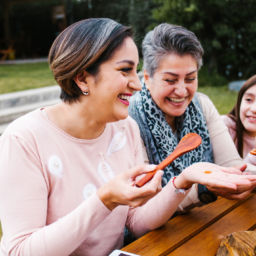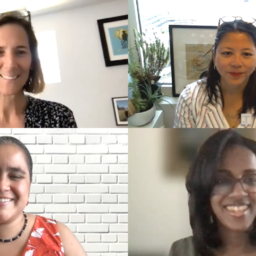The Davis Phinney Foundation is delighted to announce that the Chase Family Movement Disorders Center has been named a 2021 recipient of our Healthy Parkinson’s Communities™ grants program.
As an integral part of the Healthy Parkinson’s Communities initiative, the grants program aims to help us more fully realize our mission to help people with Parkinson’s live well today by funding programs and initiatives that are unique to the places and people they are designed to support, eliminating barriers, and expanding the possibility for all people to live well with Parkinson’s.
Improving the Health of Spanish Speaking Patients with Parkinson Disease: A New Model of Care
Undertaken by the Chase Family Movement Disorders Center (CFMDC), part of the Ayer Neuroscience Institute of Hartford HealthCare, this initiative centers around quality care for Hispanic communities in Connecticut. Goals include acquiring an accurate understanding of health disparities in the Hispanic patient population (with the goal of reducing them); improving access to subspecialized clinical care and resources, including opportunities for wellness programs and exercise; improving people with Parkinson’s health literacy about the condition; and establishing connections with local community programs and groups that serve this population.
Joy Antonelle de Marcaida, MD, says the project was designed as a multi-year initiative that starts with querying the Hispanic Parkinson’s community in the Hartford area and determining what they feel are their most pressing needs.
“We’re asking them whether there are barriers they may have encountered that hindered their ability to learn about and receive the care they deserve,” she explains, “and how they wish for us to address any health disparities that exist.”
She says that a goal of this approach—asking, rather than assuming the community’s needs, challenges, and preferences—is to see improvements in adherence to clinic visit appointments, medication compliance, and utilization of all the therapeutic interventions that are available in the community.
 In the second year, the goals are to determine the community’s preferences for formats and venues that can enhance CFMDC’s ability to provide information and education to the community that will allow them access to all the diagnostic, pharmacologic, therapeutic, non-pharmacologic interventions, exercise classes, surgical procedures, and integrative medicine options, which CFMDC offers at all their locations across the state.
In the second year, the goals are to determine the community’s preferences for formats and venues that can enhance CFMDC’s ability to provide information and education to the community that will allow them access to all the diagnostic, pharmacologic, therapeutic, non-pharmacologic interventions, exercise classes, surgical procedures, and integrative medicine options, which CFMDC offers at all their locations across the state.
Identifying needs and barriers
The need for this initiative was clear, Maria Moro-de Casillas, MD, says. “As a Hispanic myself, throughout my career I have observed that Hispanic people with Parkinson’s did not have the same access as the majority of other people with this condition in the US, and not only to state-of-the-art treatments and interventions. They also lack access to the educational resources and opportunities that we know are so important in assisting people to better understand their illness and to become their own self advocates.”
Dr. Moro-de Casillas adds that while language is a barrier, it’s not the only one that must be addressed to raise the standard of care for this population. “What we really need is culturally competent care,” she says. “This is really what we aim for through the Chase Family Movement Disorders Center.”
“We recognize that there are several barriers, but probably the most important one is a cultural one.”
-Maria Moro-de Casillas, MD
Addressing this barrier is one of the aspects of the project that most excites her. “I’m excited to bring to my Hispanic patients who are suffering from Parkinson’s state-of-the-art medical care and the latest advances in scientific development in a culturally competent way,” she says. “It’s really gratifying when you open the horizon for these people who maybe didn’t really understand their condition, who didn’t know there were treatment choices. And when we better understand their needs and develop specific programs to address those needs, we are hopefully not just improving our microenvironment here in Connecticut, but creating a model that can spread across the US.”
Collecting the data
One important component of the project is data collection. “We really do need to understand this diverse patient population’s needs and develop responsive programs to those needs,” says Duarte Goncalves Machado, MD. To do that, they need in-depth data to review. “This grant from the Davis Phinney Foundation helps fund a unique opportunity to design and create a detailed economic health database for this patient population and allows for comprehensive data collection to better describe the many aspects of Parkinson’s in this population, the ones that are not well understood.”
 When they opened the movement disorder clinic at Hartford in October of last year, “we recognized immediately that some of the assumptions we’d held about the community—what they may want, what they may need, what they may find helpful—were not necessarily resonating with them,” Dr. de Marcaida says.
When they opened the movement disorder clinic at Hartford in October of last year, “we recognized immediately that some of the assumptions we’d held about the community—what they may want, what they may need, what they may find helpful—were not necessarily resonating with them,” Dr. de Marcaida says.
“This was the reason creating the dataset was our first short-term goal. We really felt that we needed to stop assuming and instead simply ask them directly, How can we better serve you?”
-Joy Antonelle de Marcaida, MD
Long-term goals
The long-term goals of the project are twofold. The first is to extend direct patient services across Connecticut using targeted culturally appropriate educational materials that people with Parkinson’s and their families can benefit from, covering everything from exercise, stress management, and medication adherence to more difficult topics like palliative care. “We want to offer the whole breadth of resources that people with Parkinson’s may need,” Dr. Machado says.
The broader goal is to create a model that can be used by communities all around the country doing similar work. “The creation of the database will, we hope, serve as a source of information,” he says, “so that other centers can see what we’ve done and therefore do not have to reinvent the wheel. They can review our data collection and replicate the process at centers across the country and even beyond.
Through this kind of model, he says, “we can all best understand all the different aspects of treating this patient population instead of just proceeding based on assumptions. We can instead really create a new standard of care for Hispanic people with Parkinson’s.”
Hopes for the future
Dr. Moro-de Casillas says that in the past, the standard of care didn’t take into account the unique cultural backgrounds of the people who are living with Parkinson’s. “The fact that we are talking about this one-size-fits-all standard changing—that’s a major breakthrough. And if we can translate that idea into actually changing the way we practice medicine, changing the way we think, changing the way we do things, then that will be a major victory.”
Dr. Moro-de Casillas shares this sentiment. “We have a lot of hopes. And we’re ready to work very hard and to face the challenges because the end goal is to improve the care of our Hispanic people with Parkinson’s across the country.”
LEARN MORE ABOUT OUR HEALTHY PARKINSON’S COMMUNITIES INITIATIVE
Healthy Parkinson’s Communities is an initiative led by the Davis Phinney Foundation to help support community leaders, volunteers, and advocates in the pursuit of making the places where we live, work, and play more inclusive and supportive for those living with Parkinson’s. Learn more here.












